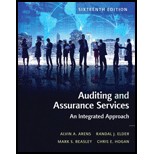
Auditing and Assurance Services (16th Edition)
16th Edition
ISBN: 9780134065823
Author: Alvin A. Arens, Randal J. Elder, Mark S. Beasley, Chris E. Hogan
Publisher: PEARSON
expand_more
expand_more
format_list_bulleted
Question
Chapter 8, Problem 28.3MCQ
To determine
Identify the circumstances under which an auditor of an issuer would be least likely to reevaluate established materiality levels.
Expert Solution & Answer
Want to see the full answer?
Check out a sample textbook solution
Students have asked these similar questions
Need help with this question solution general accounting
Horizon Ltd. signs a four-year lease agreement with Orion Inc. The
agreement requires annual beginning-of-the-year payments of
$12,000. The fair value of the lease is $44,000. Over the lease period,
how much interest will Horizon Ltd. pay?
A manufacturing firm currently operates with 120 production plants. The depreciation rate for these plants is 8%, and the real rate of interest offered by banks is 6%. How much should the firm invest to augment its capital stock? (Round your calculation to nearest number) a. 09 b. 17 c. 21. D. 25
Chapter 8 Solutions
Auditing and Assurance Services (16th Edition)
Ch. 8 - Prob. 1RQCh. 8 - Prob. 2RQCh. 8 - Prob. 3RQCh. 8 - Prob. 4RQCh. 8 - Prob. 5RQCh. 8 - Prob. 6RQCh. 8 - Prob. 7RQCh. 8 - Prob. 8RQCh. 8 - Prob. 9RQCh. 8 - Prob. 10RQ
Ch. 8 - Prob. 11RQCh. 8 - Prob. 12RQCh. 8 - Prob. 13RQCh. 8 - Prob. 14RQCh. 8 - Prob. 15RQCh. 8 - Your client, Harper Company, has a contractual...Ch. 8 - Prob. 17RQCh. 8 - Prob. 18RQCh. 8 - Prob. 19RQCh. 8 - Prob. 20RQCh. 8 - Prob. 21RQCh. 8 - Prob. 22RQCh. 8 - Prob. 23RQCh. 8 - Prob. 24RQCh. 8 - Prob. 25.1MCQCh. 8 - Prob. 25.2MCQCh. 8 - Prob. 25.3MCQCh. 8 - Prob. 26.1MCQCh. 8 - Prob. 26.2MCQCh. 8 - Prob. 26.3MCQCh. 8 - Which one of the following statements is correct...Ch. 8 - Prob. 27.2MCQCh. 8 - Prob. 27.3MCQCh. 8 - Prob. 28.1MCQCh. 8 - Prob. 28.2MCQCh. 8 - Prob. 28.3MCQCh. 8 - Prob. 29DQPCh. 8 - Prob. 30DQPCh. 8 - Prob. 31DQPCh. 8 - Your comparison of the gross margin percent for...Ch. 8 - Prob. 33DQPCh. 8 - Prob. 34DQPCh. 8 - Prob. 35DQPCh. 8 - Prob. 36DQPCh. 8 - Prob. 37DQPCh. 8 - Following are statements of earnings and financial...
Knowledge Booster
Similar questions
- Compute the meterialsarrow_forwardSkyline Enterprises' CVP income statement includes sales of 5,500 units, a selling price of $120 per unit, variable expenses of $75 per unit, and fixed expenses of $140,000. What is the net income? a. $82,500 b. $125,000 c. $107,500 d. $75,000arrow_forwardFinancial Accountingarrow_forward
- Don't use ai given answer accounting questionsarrow_forwardDuring 20x2 Creswell Corporation sold $5,500 of inventory on credit. The company's beginning and ending accounts receivable balances were $30,000 and $32,500, respectively. How much cash did Creswell Corporation collect on the account? If the ending accounts receivable had been $27,000, how much cash would Creswell Corporation have collected?arrow_forwardHow much cash was collected from customers during 2023 on these general accounting question?arrow_forward
arrow_back_ios
SEE MORE QUESTIONS
arrow_forward_ios
Recommended textbooks for you
 Auditing: A Risk Based-Approach (MindTap Course L...AccountingISBN:9781337619455Author:Karla M Johnstone, Audrey A. Gramling, Larry E. RittenbergPublisher:Cengage Learning
Auditing: A Risk Based-Approach (MindTap Course L...AccountingISBN:9781337619455Author:Karla M Johnstone, Audrey A. Gramling, Larry E. RittenbergPublisher:Cengage Learning Auditing: A Risk Based-Approach to Conducting a Q...AccountingISBN:9781305080577Author:Karla M Johnstone, Audrey A. Gramling, Larry E. RittenbergPublisher:South-Western College Pub
Auditing: A Risk Based-Approach to Conducting a Q...AccountingISBN:9781305080577Author:Karla M Johnstone, Audrey A. Gramling, Larry E. RittenbergPublisher:South-Western College Pub

Auditing: A Risk Based-Approach (MindTap Course L...
Accounting
ISBN:9781337619455
Author:Karla M Johnstone, Audrey A. Gramling, Larry E. Rittenberg
Publisher:Cengage Learning

Auditing: A Risk Based-Approach to Conducting a Q...
Accounting
ISBN:9781305080577
Author:Karla M Johnstone, Audrey A. Gramling, Larry E. Rittenberg
Publisher:South-Western College Pub
